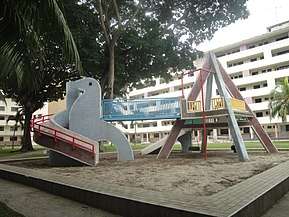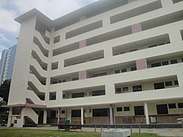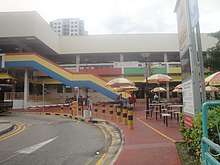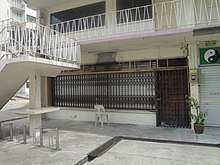Architecture of Dakota Crescent
Dakota Crescent is one of the oldest public housing estates in Singapore. It is located to the south of Old Airport Road in the Old Kallang Airport Estate. On 25 July 2016, the Housing and Development Board(HDB) announced its plans to refurbish Dakota Crescent as a site for ‘future residential development’. All its residents have relocated on 31 December in the same year.

History
1930s–1940s- Dakota Crescent was constructed by the Singapore Improvement Trust(SIT), a government body set up by the British colonial government in 1927. Initially, the SIT was not concerned with the large-scale construction of public housing, but rather improvement works to existing infrastructure and providing homeless people from these improvement works with a place to stay. Thus, during this period of time, the SIT made improvement works to the existing developments in Singapore; and constructed new roads and open spaces.
As there were inadequate housing for the increasing population in Singapore, new housing estates had to be built to accommodate more residents. At that time, many people were living in slum-like conditions where there was poor sanitation. Thus, SIT started to build houses and flats for the lower-income population.
1950s- SIT started to build satellite towns, which consisted of its own amenities. Such amenities enabled the individual towns to become self-sufficient, and include clinics, markets, schools and cinemas. The colonial government at that time planned for a public housing estate near the old Kallang Airport area.[1] It was known as the Kallang Airport Estate.[2]
1955 – The Kallang Airport (opened in 1937) closed down and a new airport was built at Paya Lebar. The old airport runway was converted into a road and named Old Airport Road. Today, Old Airport Road runs parallel to Dakota Crescent.
1958–59 – The SIT built a series of low-rise flats in the Kallang Airport Estate, naming the area Dakota Crescent. After its completion in 1959, the estate had 2,936 housing units and modern housing services such as electricity. Dakota Crescent housing estate is known to have numerous open spaces planned for social interactions between its residents, one of its most unique features. Also, it is a mini town with several shops, a market, a clinic and schools. These features of the estate most likely appeared due to the plans passed down from the improvement plan from the SIT. The absence of a back lane could be due to the fact that the board realised the back lanes created overcrowding problems in the 1930s.
Dakota Crescent was named after the Douglas DC-3 Dakota, which crashed at Kallang Airport in 1946.
1960 –The public housing programme was taken over by the HDB. SIT handed Dakota Crescent over to its successor, HDB.
1961 – Dakota Crescent was also used to rehouse the victims of the Kampong Tiong Bahru Fire in 1961.
Dakota Crescent was also the first estate to have one-room flats. It was a bustling neighbourhood which provided a decent standard of living for its residents. There were rubbish chutes on every floor and water/electricity pipes that ran through the entire block. This was a significant change from the poor sanitary conditions that the population used to live in. Many Dakota residents forged strong friendships with one another since then. As such, it gave the aged residents a sense of belonging to the place.
2016 – The housing estate is mostly occupied by elderly residents and low-income families. On 31 December 400 households in Dakota Crescent were relocated. Many residents have been given one or two-room residential flats at 52 Cassia Crescent, a new block located 400m away from Dakota Crescent. Few residents remain in the estate, as they await the completion of their new flats or are simply adamant to allowing the estate to be torn down.
Architecture and Surrounding Features
The neighbourhood had 4 different types of blocks – "pi-shaped blocks (butterfly- shaped blocks)", 3-storey walk up apartments, 7-storey slab blocks and a 2-storey shop house. The pi-shaped block has a partially enclosed yard between the two ‘wings’. The butterfly blocks were designed this way to allow for better ventilation for the units in between the two wings. The shorter blocks are lined up along Dakota Crescent and brings ‘the scale of the closer to the ground’.[3] The rest of the blocks surround spacious square courtyards, where the dove playground is built.


These areas allowed the community to interact and was a common space for various community activities. Many residents recalled meeting their childhood friends at the dove playground. Parents would monitor their children from above in their flats in the butterfly blocks and the sound of children playing at the playground gave them reassurance that their children were safe. As residents of different races and dialects lived together in the same block, many who grew up in Dakota could understand the multiple dialects and languages.


Compared to other housing estates in its time, Dakota Crescent was built in a unique architecture where there are many open spaces in between the blocks. This allows Dakota Crescent to maintain its iconic streetscape. However, in view of land scarcity in Singapore, Dakota Crescent has to be demolished to make way for future land needs. It is speculated that the land area would be used for interim purposes such as student hostels, workers’ dormitories, etc. Dakota's prime location – close to the city – makes it a good area for future urban developments.
Geylang River runs nearby to Dakota Crescent. It too, has a rich history. In the 1840s, there were many kampong villages situated on the river bank. Many Dakota residents recall occasions where crocodiles were spotted crawling out of the river and near their homes. Also, at night, the area behind the canal had a peaceful atmosphere. Today, efforts are put in to extend and deepen the river. It is expected that its increased drainage capacity would be a protection against floods in future. The river runs along a park connector to provide for family activities for the nearby residents who are currently staying in condominiums beside Dakota Crescent today.

Today, Dakota Crescent provides a combination of the old and the new. At one end of the street, old Housing and Development Board(HDB) blocks still exist, while new high rise condominiums stand at the other end. 4/5 of the blocks in Dakota have already been demolished to make way for the condominiums Dakota Residences and Waterbank at Dakota. Schools that are located in close proximity to these residences include Broadrick Secondary School, School of the Arts, and Etonhouse International School. Dakota Crescent has become increasingly accessible, with two nearby MRT stations- Dakota and Mountbatten. Today, Dakota Crescent is almost like a dead estate even though modern shops such as NTUC and other basic amenities line the road opposite of the estate.
In addition, the popular Old Airport Road food centre at the same area provides for the main source of dining for the residents today. It was constructed in 1973 and is also a famous hotspot for tourists to taste delicious local food today. This popular tourist destination could be one of the main reasons why Dakota Crescent was brought to the attention of many today.
While there are plans to conserve this old piece of history, some others argue that there is a need to inject life and activity into this ‘dead town’.
Uniquely Dakota
Tian Kee & Co Provision Shop
Tian Kee & Co was set up in 1958, owned by a couple. It was an old provision shop in Dakota Crescent located at the corner of block 12. It has an antique signboard and rusty metal gates. It was 54 years old when it closed down last year.

The shop sold biscuits in metal tins, while drinks and other perishables were displayed on the shelves and in baskets. Residents would drop by the provision shop often as it was convenient. Many children ran to the provision shop for ice-cream and left without paying. As such, the couple who owned the shop kept a tab and placed the invoice on families at the end of every month. As with most old provision shops, the shop had limited space. Traditional provision shops faced competition from other new supermarkets and convenience stores. The number of provision shops has dropped significantly since the 70s.
This provision shop was converted into a retro-styled café subsequently. It maintained a nostalgic touch of the olden days, as milo tin, biscuit tins and old Chinese calendars could be found in the modern café. The café sold deserts such as rainbow cheese cakes and drinks.
Personal Recounts
However, what makes[Dakota Crescent truly unique is its people. There are many stories of Dakota Crescent, such as those from a karaoke-loving couple and a former hairstylist. The following are some personal recounts from the residents who lived in Dakota.
Mdm Lee Soh Meng, who has lived at Dakota for close to six decades : "Everything feels familiar here, the neighbours are amiable and we greet one another," said the 81-year-old in Mandarin. Still, she added: “I miss the good old times, where the environment was friendlier."
Mdm Lee recounts it being a very boisterous neighbourhood in the past. "60 years ago, there were many kids around here and they would fight at the playground," she said. Those kids have since grown up and moved away as they started their own families.
Saving Dakota
A group of architects has put together a conservation paper to save Dakota Crescent. One of the ideas is to conserve the entire estate and transform it into a modern space with food and beverages businesses and hotels. The paper has been submitted to the Ministry of National Development.
The ‘Save Dakota Crescent’ campaign was started in 2014. This campaign was set up as its founders felt that Dakota Crescent had a unique architecture- one that had open spaces, iconic buildings and an interesting streetscape. Thus, it was a piece of history that they wanted to keep, for the future generation and as a part of Singapore's heritage.
Other than its architectural significance, Dakota also has a historical and social significance. Many residents still hold fond memories of the place, as can be seen by the personal recounts above, and has appealed to the government to conserve certain parts of this estate. Some of these residents have joined the campaign led by the architects. Dakota Crescent has a huge historical significance, as it was one of the first housing estates to be built in response to the increasing population.
Projects that the group has embarked on include conducting walking trails for people who wanted to know more about the history and architecture of the estate. The walking trails are conducted by the residents of Dakota. This makes the trails more interactive for visitors, rather than walking about the estate on their own. Furthermore, these residents can share their personal experiences about the estate with the visitors, enhancing their understanding about the social significance of Dakota. The group has also created Facebook pages ‘Save Dakota Crescent’ and ‘Dakota Adventures’ to raise awareness about their plans to the members of the public.
The Urban Redevelopment Authority (URA) has also preserved certain heritage estates such as the Tiong Bahru and Kampong Silat areas. They are currently evaluating the proposal submitted to conserve Dakota. The outcome is optimistic as there has been ‘promising signals from the government’, ‘no confirmed plans to demolished the estate yet’ and ‘strong conservation from the ground’,[4] as mentioned in January this year.
It is highly encouraging that residents are starting to take ownership of their community and putting in a significant amount of collective effort to conserve their housing estate. Such attitude should be encouraged in other Singaporeans as well, taking ownership of their community and making plans for the future.
References
- "Dakota Crescent: Why we should keep this piece of living history alive" (PDF). Archived from the original (PDF) on 29 October 2015. Retrieved 3 February 2017.
- "Housing in Singapore". Retrieved 3 February 2017.
- "Dakota Crescent Neighbourhood". Retrieved 3 February 2017.
- "3 reasons why we can be optimistic about Dakota Crescent's conservation". Retrieved 18 February 2017.
- Teo Alida. "Housing in Singapore." List of Singapore Improvement Trust Estates. 2 July 2015. Retrieved 3 February 2017. http://www.teoalida.com/singapore/sitlist/
- Paveena Seah. "Dakota Crescent: Why we should keep this piece of living history alive." 2014. Retrieved 3 February 2017. http://lkyspp.nus.edu.sg/ips/wp-content/uploads/sites/2/2014/09/8_Dakota-Crescent-Why-We-Should-Keep-This-Piece-of-Living-History-Alive_120914.pdf
- "5 Things to know about Dakota Crescent before its gone." Singapore Home Decor. 4 June 2016. Retrieved 3 February 2017. http://www.homeanddecor.com.sg/articles/80228-5-things-know-about-dakota-crescent-its-gone
- Susan. "Singapore Heritage Playgrounds – Dove Playground, Dakota Crescent." A juggling Mom. 2 March 2015. Retrieved 3 February 2017. http://ajugglingmom.com/singapore-heritage-playgrounds-dove-playground-dakota-crescent/
- Stephanie Ho. "Singapore Improvement Trust." Singapore Improvement Trust. 14 March 2016. Retrieved 3 February 2017. http://eresources.nlb.gov.sg/infopedia/articles/SIP_2016-03-14_142655.html
- Michelle Yee. "Eye on Dakota: A slice of history." Eye on Dakota: A slice of history. 17 August 2015. Retrieved 3 February 2017. https://sg.news.yahoo.com/eye-dakota-slice-history-023024590.html
- Carolyn Khew. "Homage to history at Geylang River." Carolyn Khew. 5 January 2014. Retrieved 10 February 2017. http://www.straitstimes.com/singapore/homage-to-history-at-geylang-riverKallang Airport- https://www.ura.gov.sg/uol/conservation/conservation-xml.aspx?id=FKA
- "Remember Singapore." Dakota Crescent Provision Shop. 8 September 2011. Retrieved 10 February 2017. https://remembersingapore.org/dakota-crescent-provision-shop/
- "Dakota Crescent Neighbourhood." Dakota Crescent Neighbourhood. 13 September 2014. Retrieved 10 February 2017. https://lostnfiledsg.wordpress.com/2014/09/13/dakota-crescent-neighbourhood/http://www.straitstimes.com/singapore/group-pushing-to-save-dakota-crescent
- Melody Zaccheus. "Parliament: Lim Biow Chuan asks Govt to reconsider plans to redevelop Dakota Crescent." Parliament: Lim Biow Chuan asks Govt to reconsider plans to redevelop Dakota Crescent. 10 October 2016. Retrieved 18 February 2017. http://www.straitstimes.com/singapore/parliament-lim-biow-chuan-asks-govt-to-reconsider-plans-to-redevelop-dakota-crescent
- Krystal Chia. "Long-time residents of Dakota Crescent turn tour guides." Long-time residents of Dakota Crescent turn tour guides. 15 February 2016. Retrieved 18 February 2017. http://www.tnp.sg/news/singapore/long-time-residents-dakota-crescent-turn-tour-guides
- Kok Yufeng. "A different walk to remember in Dakota." A different walk to remember in Dakota. 15 February 2016. Retrieved 18 February 2017. https://sg.news.yahoo.com/a-different-walk-to-remember-in-dakota-013833150.html
- Henedick Chng. "3 reasons why we can be optimistic about Dakota Crescent’s conservation." 3 reasons why we can be optimistic about Dakota Crescent’s conservation. 18 January 2017. Retrieved 18 February 2017. http://mothership.sg/2017/01/3-reasons-why-we-can-be-optimistic-about-dakota-crescents-conservation/
- Desmond Lim. "People behind the old charm at Dakota Crescent." People behind the old charm at Dakota Crescent. 9 July 2015. Retrieved 18 February 2017. http://www.straitstimes.com/singapore/people-behind-the-old-charm-at-dakota-crescent
- Also, special thanks to Mr Cai Yinzhou, the founder of Geylang Adventures and the residents of Dakota Crescent for providing me with valuable insights that greatly aided the completion of my project.